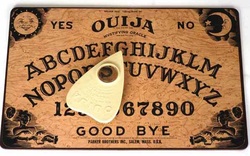
~Jamie Pearce
The Ouija board also known as a spirit board or talking board, is a flat board marked with the letters of the alphabet, the numbers 0–9, the words "yes", "no", "hello" (occasionally), and "goodbye", along with various symbols and graphics. It uses a planchette (small heart-shaped piece of wood) or movable indicator to indicate the spirit's message by spelling it out on the board during a séance. Participants place their fingers on the planchette, and it is moved about the board to spell out words. "Ouija" has become a trademark that is often used generically to refer to any talking board.
Following its commercial introduction by businessman Elijah Bond on July 1, 1890, the Ouija board was regarded as a harmless parlor game unrelated to the occult until American Spiritualist Pearl Curran popularized its use as a divining tool during World War I.
Mainstream religions and some occultists have associated use of an Ouija board with the concept of demonic possession, and view the use of the board as a spiritual threat and have cautioned their followers not to use an Ouija board.
One of the first mentions of the automatic writing method used in the Ouija board is found in China around 1100 AD, in historical documents of the Song Dynasty. The method was known as Fuji, "planchette writing". The use of planchette writing as an ostensible means of contacting the dead and the spirit-world continued, and, albeit under special rituals and supervisions, was a central practice of the Quanzhen School, until it was forbidden by the Qing Dynasty.
*Obtained from Wikipedia.org*

 RSS Feed
RSS Feed